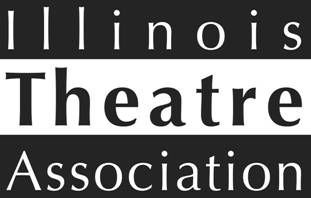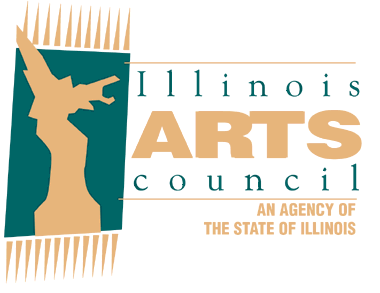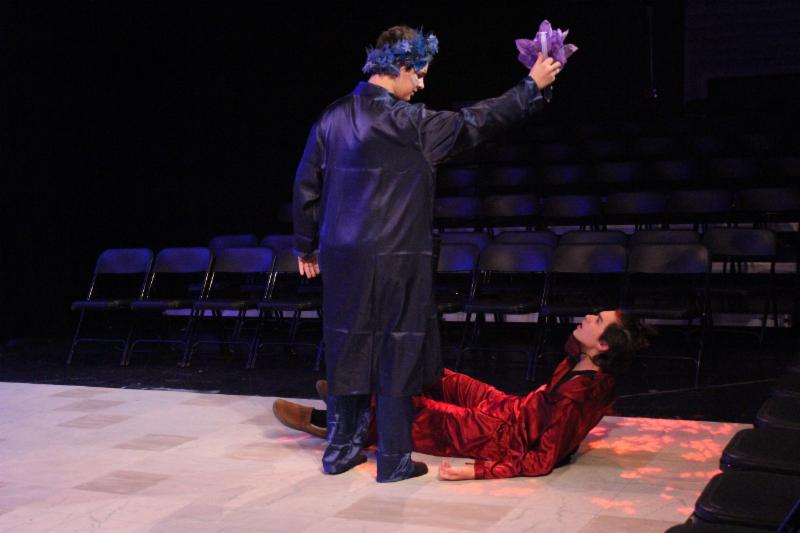ITA EVENTS
February 25-26, 2017
University of Illinois at Chicago
EVENTS OF INTEREST FROM ITA MEMBERS
March 4, 2017
Grand Stage Theatrical Skills Workshop:
Safe Rigging: "Heads up!"
Streamwood High School
April 27-30, 2017
MAKE IT CHAMPAIGN! A Toast to Theatre Excellence
Region III AACTFEST
Parkland College
Champaign, IL Click Here
|
JOB POSTINGS
The Latin School of Chicago announces an opening for a Technical Theatre position.
Carmel Catholic High School is hunting for a part-time tech director for Fine Arts events. Lighting and sound only.
Click here to visit the ITA's Job Board for details and more postings!
AUDITION ANNOUNCEMENTS
2/25-2/26 ITA's Statewide Professional Non-Equity Auditions Click here to visit the ITA's Audition Announcements for more details.
|
FEATURED PERFORMANCES
Lewis University
Good People
2/23/17-2/26/17
Thur., Fri., & Sat. at 8:00p
Sat., Feb. 25 at 4:00p & 8:00p
Sun. at 2:30p
Region 2: Romeoville
GreenMan Theatre
The McAddams Family: Spring Break
2/24/17-3/5/17
Fri. & Sat. at 7:00p
Sunday, March 5 at 6:00p
Region 2: Elmhurst
Oak Park and River Forest HS
Mary Poppins
2/25/17-3/5/17
Fri. & Sat. at 7:30p
Sun. at 3:00p
Region 3: Greater Chicago
Independent Players
Eleemsonary
3/3/17-3/18/17
Fri. & Sat. at 8:00p
Region 2: Elgin
Want your performance to be featured here?
|
Join the ITA on Facebook:
|
|

The ITA is a network of dedicated theatre artists and educators advocating quality theatre throughout Illinois. Please join us!
123 Mill Pond Dr.
Glendale Heights, IL 60139
312-265-5922 (office)
312-265-6101 (fax)
|
|
Please Visit ITA's Corporate Sponsors:
Associate Corporate Sponsors:
Bill Conner Associates LLC
|
|

The Illinois Theatre
Association is partially
supported by a grant from
the Illinois Arts Council,
a state agency.
|
|
eFOLLOWSPOT  February, 2017 February, 2017
|
FIVE REASONS A COMMUNITY THEATRE NEEDS A STRATEGIC PLAN
By Kathy Missel
You've all heard the saying, "If you fail to plan, you plan to fail." While we may think of this most often in the context of financial planning, it's equally important for community theatre organizations. Why is a strategic plan so important? Simply put, your strategic plan helps spell out where the organization is going and how it's going to get there. If your group has never conducted a formalized strategic planning session, consider making this the year that you make that a reality.
Developing a strategic plan takes time and resources. It requires time and commitment from everyone in the organization. With that being said, why even take time for strategic planning?
1. To set direction and priorities
Your session will define your theatre's view of success and prioritize activities. The strategy will help you know what it is should be working on and what you should be working on first.
2. To get everyone on the same page
Let's face it: theatre boards are often made up of diverse individuals who have their own idea of what your organization should be. Hidden, and sometimes not-so-hidden, agendas can quickly derail a group. If you find that you have different factions working to achieve different aims, you need a strategy. Once you define your strategic direction as a group, you can get everyone moving together to achieve those goals.
3. To simplify the decision making
Having clearly-defined priorities makes it easier to say no to distracting initiatives once you determine that they do not meet your strategic plan. At the same time, if your theatre finds it difficult to embrace new ideas, a strategy can demonstrate the need and help you develop action items for success.
4. To drive alignment
Many groups are full of hard-working people putting all of their efforts into areas that have little to no effect on strategic success. Their activities aren't aligned with strategic priorities. Your plan serves as the directive for answering the question, "How can we better align our resources to maximize our strategic success?
5. To communicate the vision
Many leaders have a vision in mind of what they want their organization to look like. But if that strategy has been developed in a vacuum and not as a group, you lack buy-in. Buy-in is critical in communicating the vision. When you create and communicate that vision, you allow greater opportunities for your volunteers to be successful in achieving your goals.
Think of strategic planning as your theatre's GPS. Remember Yogi Berra once said, "If you don't know where you are going, you are certain to end up somewhere else." Invest time now in developing your road map now to look ahead to the future and making your dreams and plans a reality.
|
CELEBRATED COSTUMER "adDRESSES" YOUNG DESIGNERS
John Nasca's infectious laugh accompanies his first piece of advice for young costume designers: "Run. The other way!"
It's that undaunted sense of humor - and enormous talent - that have made Nasca a highly respected designer on Chicago's robust theatre scene. In addition to his Joseph Jefferson Award for Design for Living, John has garnered six Jeff nominations for Best Costumes - the most non-Equity costume nominations ever -- and accolades as founder/artistic director and costumer of Glitterati Productions.
Design for Living, John Nasca costumer, Pride Films and Plays. Clockwise-from-Lower-Left, Matthew Gall, Carmen Molina, Mike Newquist, Kevin Webb, Joan McGrath, and Nora Lise-Ulrey.
"Most of the young costumers I run into don't have a clear picture of how things are in the real world. They graduate from colleges that put money and resources at their fingertips." Then they land a real assignment at a storefront theatre and, literally, the cloth is pulled from in front of them. "My advice: drop your expectations and dig in. If you have a real passion for design, you can rise above whatever roadblocks you confront and do what you love."
Nasca offers these "roadblock fly-overs" to the many young designers he mentors.
EXPECT ANYTHING. "There are always surprises," he chuckles.
In a career that spans three decades, Nasca has had his share:
- A re-scheduling SNAFU that had him opening three shows within 72 hours.
- An Equity actress who took John's specifically purchased and painstakingly styled wigs into her dressing room - and combed them out and restyled them because she felt the period styles weren't "flattering".
- And recently, the extension of Pride Films and Plays' production of Priscilla, Queen on the Desert (featuring over 200 John-executed costumes), which involved recasting two principal singers and re-executing dozens of outfits. "You can't re-cast by size?" he joked.
MAKE SURE YOU KNOW UPFRONT WHAT IS INCLUDED IN YOUR COSTUME BUDGET. Does the producer presume you'll be supplying wigs and makeup? Are actors providing their own tights and hose? Do actors have the correct undergarments? What about shoes? People often don't think about footwear - until the musical chorus performers in dressed-alike costumes all show up with conspicuously different tap shoes.
INVESTIGATE ON-LINE SOURCES FOR WARDROBE PIECES. Before the internet, costumers would spend endless time combing resale and thrift stores. Today, there are many costume groups on line where you can ask questions and get good and rapid advice.
ASK QUESTIONS. FROM THE START, TRY TO GET AS MUCH INFORMATION FROM THE DIRECTOR AS YOU CAN. Don't wait for the director to come to you; you'll lose valuable time. Prepare questions about his/her vision and approach him/her as early as possible in the pre-rehearsal process.
FROM THE GET-GO ALSO DEBRIEF YOUR FELLOW DESIGNERS. You can't afford to wait until someone decides what color the set will be painted. In school, designers are taught to get together and talk "concept' and "color palate." "In my 30 plus year career, only one lighting designer ever talked to me about palate. I've learned to initiate the conversation so I can get to work," says John.
ENGAGE THE ACTORS, TOO, TO MINIMIZE SURPRISES. In addition to taking measurements, try to determine upfront if they have any personal issues. Are there fabrics to which they're allergic? Are they uncomfortable exposing body parts, like their arms or back? Do they know how to wear the clothes they'll need to put on? Not all women are schooled in how to wear period costumes, handle a train, even walk in high heels. In an ideal world, fitting actors early in the rehearsal process gives them a chance to work with any problematic costumes before dress and previews. ("That doesn't happen often," John sighs.)
MAINTAIN YOUR SENSE OF HUMOR. Try to find people to work with whom you really enjoy and who will pitch in to keep his/her fellow designers going despite chaos, surprises and time constraints. "Somehow, it always works out. It's the magic of theatre."
John Nasca's career has also encompassed work as a film costumer, a bridal designer, a formal fabrics buyer, a theatre director and producer. He is directing the Midwest premiere of The Nance, a funny and poignant backstage look at burlesque theatre in the 1930's, at Pride Arts Center, 4139 N. Broadway, opening this summer. Check out John's website: glitteratiproductions.com.
|
No Black Box? No Problem.
By Jonathan Meier
Like many other theatre teachers who produce all of their shows in a single large theatre, I was more than a bit jealous of my colleagues who have a black box or studio theatre at their disposal. I yearned for my students to have the experience of performing with an audience sitting mere inches away from them. This was always my favorite kind of theatre in which to work (a million years ago when I was an actor). So a few years ago, I decided that it was time to get creative and find a way to bring this experience to my students and to the Mundelein community. It was time to turn our stage into a black box theatre. It turned out to be one of the best decisions I have made in my teaching career.
I certainly did not invent the idea of having the audience sitting onstage. I had seen it done a few times before at other schools and theatres. When I was in college, I set up a similar configuration when it turned out that the small theatre we had was unavailable for my directing class final project. The mechanics of doing this will vary greatly from school to school, depending on the stage configuration, resources and administrative support. But it is something I would highly recommend that all teachers consider doing.
My biggest concern was having enough room for adequate seating while leaving a useable playing space. Our stage is not particularly deep, so I decided a thrust configuration would work better than in the round. We ended up with a playing area roughly 25' x 25'. The total number of seats is 208. We construct the center seating section using our stock 4x8 platforms. For the side seating areas, we bring in our choir risers. We have two rows of chairs on the floor on all three sides, with the remainder being on the platforms. The first year we did this, the school did not have enough folding chairs, so we ended up renting them. The school has now purchased additional chairs, so I just have to remember to reserve them for the weekend of the show. We have four entrances and exits for our actors, one at each corner of the stage. There are many other issues that would have to be worked out, things such as adequate emergency exits and handicap/elderly access. This is where the support of your administration and maintenance staff is important.
We now do this every year at my school, usually for our winter play. Just last weekend, weperformed A Midsummer Night's Dream on the thrust. Previous years' productions have
 included Our Town, The Odd Couple (original and female versions running in alternating performances) and Tartuffe. Educationally, it is fantastic for both our students and community members to experience the theatre arts so up close and personal. For those students going on to study theatre in college, the experience of working in such a small space is invaluable. Personally, it has become my favorite production to direct each year. I find the challenge of directing on the thrust to be both challenging and invigorating. Perhaps turning your stage into a black box will do the same for you.
|
PLAY N' 90
by Jeremy Schaefer
The ITA's Jeremy Schaefer had a chance to talk to the multitalented artist and creator of Play N' 90, Paul Whitehouse, about his fantastic program. Learn more about Play N' 90 below.
ITA: Play n' 90 promises to create a brand new play in just 90 minutes, how does that work?
PW: The program is broken into three sections. In the first 30-minute section, four theatre artists lead a group of about 50 adults and children in participatory activities that teaches the audience about story, setting, and characters. In the second section, we develop characters and map out the plot with the audience's ideas. In the final section, the adults create the set and costumes, and the children rehearse the play. The children than perform the play for the adults. A play in 90 minutes!
ITA: What challenges do you encounter when opening audience members up to story creation and performance?
PW: The biggest challenge with the adults is recognizing individuals' apprehensions with performing in front of the group. As a facilitator, you always want to support and encourage people to take risks, but sometimes it is important to find ways for people to participate in nonperformance ways. It is also sometimes a challenge when filtering ideas from the children to create the story, and how to navigate if your idea isn't chosen, but it quickly becomes an important lesson in collaboration.
ITA: It's a pretty incredible thing to give young people ownership over an original piece of theatre. What kind of reactions do you get from parents and educators?
PW: Wonderful and inspiring reactions! Parents have come up to us and told us that they brought their child to help their shyness, and they are overjoyed because they are confidently performing in front of an audience by the end of the program. Parents are also thrilled that we create an inclusive environment. We strive to create a space where children of all abilities are supported and their ideas are cherished.
ITA: Where can ITA members learn more about Play N' 90 or see it in action?
|
A DAY, A PLAY #4 : THE GLOBAL GAME
By Susan Antman
We are delighted to announce the launching of the 4th edition of A day for a play, the TYA instant playwriting game, in conjunction with the ASSITEJ international theatre day (March 20th) and the ASSITEJ Congress in Cape Town (May 2017).
It's a worldwide writing game designed for easy play and enjoyment. The registration is free and open to anyone who wishes to write a short script for young audiences. And there is nothing to gain but the pleasure to share an « instant playwriting » moment with fellow storytellers and other practitioners from all around the world.
As in the past editions, it will only take 24 hours (or less) of your time during the first two weeks of March 2017 (and, at the time you register, you get to choose a day between 1st and 15th). The process will be as simple and personal as it is playful. Echoing the Cape Town Congress, our topic will be, "Where do I come from?".
On the morning of your participation in March, you'll receive some easy and fun rules; you will write your short script in your usual language. As far as possible, please just add a short summary in English or French, along with your translated title. On March the 20th, all of the scripts will be published on the WLPG website.
Then you'll receive all the details about the process.
And do not hesitate to forward this announcement to any fellow playwright of yours!
Please note that from now on, Scènes d'Enfances-ASSITEJ France is passing on the organization of the game to Write Local, Play Global.
|
|
|